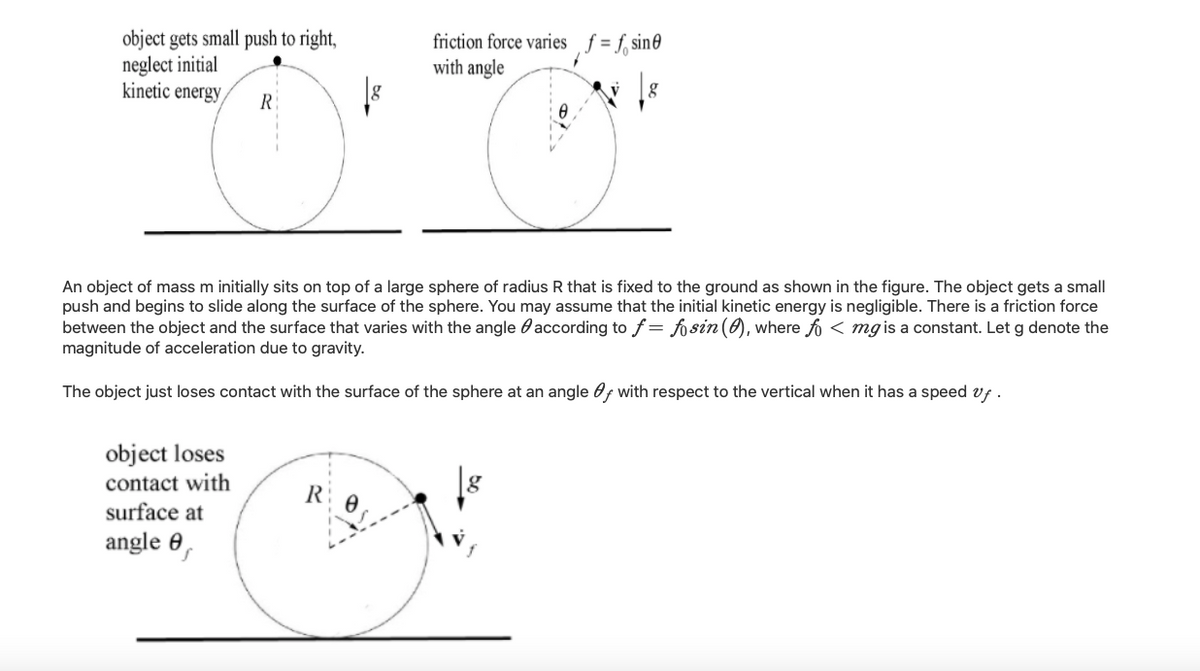(Question 1) When the object is at an angle 0 < Of, draw a free-body force diagram showing the forces acting on the object. For angles O such that 0 <0< Of, is the tangential acceleration zero or non-zero? Is the radial acceleration zero or non-zero? (Question 2) What is the work done by the friction force on the object as the object moves through the angle 0 = 0 to the angle 0 = ? Hint: the small displacement of the object on the surface of the sphere is given by dr = Rd00 . Write your answer using some or all of the following: f_0 for fo , R, theta_f for 0;and cos() for cosine. (Notice, In case of math expression you need to be precise. fo cos(@) For example, if your answer is , you need to write it as f_0*cos(theta_f)/R. R
(Question 1) When the object is at an angle 0 < Of, draw a free-body force diagram showing the forces acting on the object. For angles O such that 0 <0< Of, is the tangential acceleration zero or non-zero? Is the radial acceleration zero or non-zero? (Question 2) What is the work done by the friction force on the object as the object moves through the angle 0 = 0 to the angle 0 = ? Hint: the small displacement of the object on the surface of the sphere is given by dr = Rd00 . Write your answer using some or all of the following: f_0 for fo , R, theta_f for 0;and cos() for cosine. (Notice, In case of math expression you need to be precise. fo cos(@) For example, if your answer is , you need to write it as f_0*cos(theta_f)/R. R
College Physics
11th Edition
ISBN:9781305952300
Author:Raymond A. Serway, Chris Vuille
Publisher:Raymond A. Serway, Chris Vuille
Chapter1: Units, Trigonometry. And Vectors
Section: Chapter Questions
Problem 1CQ: Estimate the order of magnitude of the length, in meters, of each of the following; (a) a mouse, (b)...
Related questions
Question
Question 3. What is the work done by the gravitational force on the object as the object moves through the angle θ=0 to the angle θ=θf ? Write your answer using some or all of the following: m, g, R, theta_f for θf and cos() for cosine.

Transcribed Image Text:object gets small push to right,
neglect initial
kinetic energy
friction force varies f = f, sin0
with angle
R
An object of mass m initially sits on top of a large sphere of radius R that is fixed to the ground as shown in the figure. The object gets a small
push and begins to slide along the surface of the sphere. You may assume that the initial kinetic energy is negligible. There is a friction force
between the object and the surface that varies with the angle 0according to f = fo sin (0), where fo < mg is a constant. Let g denote the
magnitude of acceleration due to gravity.
The object just loses contact with the surface of the sphere at an angle Of with respect to the vertical when it has a speed vf .
object loses
contact with
surface at
R
angle 0,

Transcribed Image Text:(Question 1) When the object is at an angle 0 < Of, draw a free-body force diagram showing the forces acting on the object. For angles
O such that 0 < 0< Of, is the tangential acceleration zero or non-zero? Is the radial acceleration zero or non-zero?
(Question 2) What is the work done by the friction force on the object as the object moves through the angle 0 = 0 to the angle 0 = 0f
? Hint: the small displacement of the object on the surface of the sphere is given by dr = Rd00 . Write your answer using some or all of the
following: f_0 for fo , R, theta_f for 0fand cos() for cosine. [Notice, In case of math expression you need to be precise.
fo cos(0)
R
, you need to write it as f_0*cos(theta_f)/R.
For example, if your answer is
Expert Solution
This question has been solved!
Explore an expertly crafted, step-by-step solution for a thorough understanding of key concepts.
This is a popular solution!
Trending now
This is a popular solution!
Step by step
Solved in 2 steps with 2 images

Knowledge Booster
Learn more about
Need a deep-dive on the concept behind this application? Look no further. Learn more about this topic, physics and related others by exploring similar questions and additional content below.Recommended textbooks for you

College Physics
Physics
ISBN:
9781305952300
Author:
Raymond A. Serway, Chris Vuille
Publisher:
Cengage Learning

University Physics (14th Edition)
Physics
ISBN:
9780133969290
Author:
Hugh D. Young, Roger A. Freedman
Publisher:
PEARSON

Introduction To Quantum Mechanics
Physics
ISBN:
9781107189638
Author:
Griffiths, David J., Schroeter, Darrell F.
Publisher:
Cambridge University Press

College Physics
Physics
ISBN:
9781305952300
Author:
Raymond A. Serway, Chris Vuille
Publisher:
Cengage Learning

University Physics (14th Edition)
Physics
ISBN:
9780133969290
Author:
Hugh D. Young, Roger A. Freedman
Publisher:
PEARSON

Introduction To Quantum Mechanics
Physics
ISBN:
9781107189638
Author:
Griffiths, David J., Schroeter, Darrell F.
Publisher:
Cambridge University Press

Physics for Scientists and Engineers
Physics
ISBN:
9781337553278
Author:
Raymond A. Serway, John W. Jewett
Publisher:
Cengage Learning

Lecture- Tutorials for Introductory Astronomy
Physics
ISBN:
9780321820464
Author:
Edward E. Prather, Tim P. Slater, Jeff P. Adams, Gina Brissenden
Publisher:
Addison-Wesley

College Physics: A Strategic Approach (4th Editio…
Physics
ISBN:
9780134609034
Author:
Randall D. Knight (Professor Emeritus), Brian Jones, Stuart Field
Publisher:
PEARSON